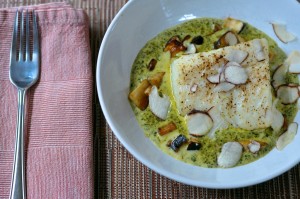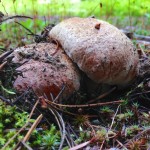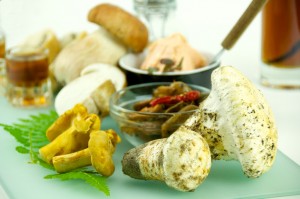I met a self-proclaimed globetrotter at a barbecue the other day who told me that in a lifetime of traveling he’d never been to the Far East. That’s funny, I said to him, because I just got back from China. He wasn’t impressed. “The Chinese can have it,” he said sourly. “It’s their century anyway.”
The old codger may be right about the 21st century being stamped with Chinese characters, though I’m at a loss to explain how a so-called “lifetime of traveling” translates into such a narrow world view. Maybe if George W. Bush had spent more time on foreign soil—rather than extolling his own provincialism—he might not have made such a mess of things in the White House. There’s one way to gain a better understanding of the world and its people: by crossing borders.
My recent trip took me to southwestern China and the Tibetan Plateau. The lens through which I glimpsed these places was fungi. Mushroom season is in full swing in the monsoon-soaked highlands and I wanted to see for myself a mushroom hunting scene that has been described as one of the busiest anywhere, with economic implications that stretch far and wide. Daniel Winkler, a member of the Puget Sound Mycological Society and proprietor of Mushroaming, was my cheerful, indefatigable tour guide (besides an encyclopedic knowledge of local custom and natural history, the guy speaks enough Tibetan to hang out with nomadic yak herders).
You’ll have to take my word for it when I say that I survived adventures this July to fill a book—or at least a lengthy essay. Much of it I’m still trying to process. China is big, jam-packed with people, and not a little overwhelming. I’ve got work ahead to bring into focus my thousands of photos, hours of audio/video, and copious notes. In the meantime, allow me to share a little of the itinerary and some accompanying images.

The trip started in Chengdu, capital of Sichuan Province, where the region’s infatuation with everything fungal was on display, at a price. Local pharmacies showed off wild medicinals such as reishi (pictured above) and Cordyceps sinensis, the caterpillar fungus. Should you seek these time-honored curatives, be prepared to open your wallet. One member of our party paid 480 rmb (about $75 US) for a dozen of the desiccated larvae of the ghost moth with their fungal parasites (called yartsa gunbu in Tibetan, with a reputation for restoring the humors, enhancing sexual prowess, and even producing Olympic Gold Medalists)—and she got a deal!
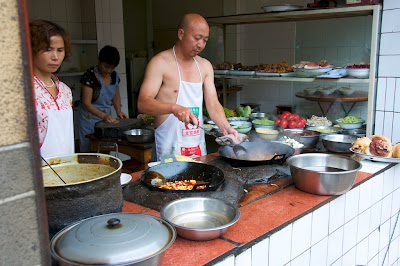
Mushrooms are widely eaten as food in the Far East, too. Restaurants in big cities and small towns alike routinely include both cultivated and wild varieties on their menus. One of the best meals of the trip was at this tiny restaurant (above) near Ya’an on the road to Kangding, where we dined on wood-ear and oyster mushrooms cooked to order by a wok-master and his wife. One of the many fun (and different) things about eating in China is seeing all the meat and produce on display in the restaurant’s glass-cased cooler; reading the menu for most of us westerners is an impossibility but one can always point.

Our first day out of Chengdu we followed rivers that I’d never heard of, rivers that, to the naked eye, would seem to dwarf the Skagit or even the Sacramento. The Red Basin is famous as the bread-basket of China, and it’s easy to see why when you start counting the major water courses that flow into it, including the 2,000-year-old irrigation diversion at Dujiangyan. There’s an unbelievable amount of water pouring out of mountains that seem to go on forever, especially during monsoon season.
We gained steady elevation, finally topping out at 8,400 feet in Kangding, a smallish city by Chinese standards with about 100,000 souls at the confluence of the Tar and Chen river gorges. Despite its size, Kangding boasted more wild mushroom dealers than I’ve ever seen in one place. Matsutake commanded the highest price, at 80 to 100 rmb per pound for #1 and #2 buttons, while the local varieties of Caesar’s amanita (Amanita hemibapha) and king bolete (Boletus sp.) were going for as much as 25 rmb for prime specimens, such as these amanita eggs below.
Other species for sale included the Himalayan gypsy (Cortinarius emodensis, below); hawk’s wing (Sarcodon sp., below); Leccinum versipelle; Catathelasma imperialis; various boletes, russulas, and chanterelles; and a Tricholoma similar to man-on-horseback.

One night we taste-tested the gypsy side by side with the mystery Tricholoma (below). The latter was favored by some, though I must say I preferred the gypsy for both taste and texture and will be looking for this mushroom more in the future. The Chinese are known for their nose-to-tail eating habits, and this catholic taste spills over into their use of fungi. Species that I don’t usually associate with the marketplace in the U.S. (e.g. Catathelasma imperialis, various russulas, and hawk’s wings) are routinely sold and eaten in China. This is in keeping with the agricultural strategy; virtually every square inch of arable land is under cultivation. With 1.4 billion inhabitants, even a nation as geographically large as China must continually think about food production.
A few days (and hard miles) later, while our drivers played cards, we investigated a likely slice of matsutake habitat in the oak forests above Yajiang with the help of a young Tibetan and his aunt (pictured below).
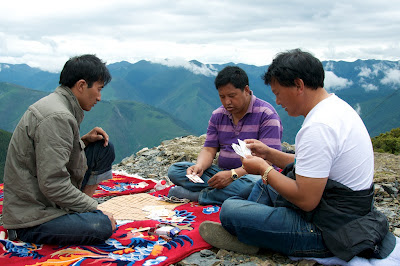
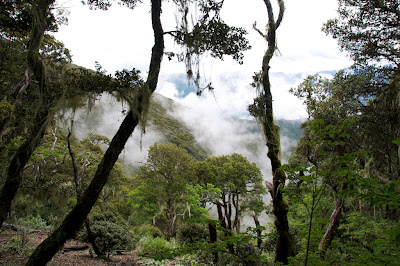
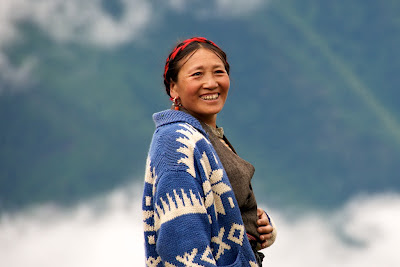
Fresh divots in the forest floor told the story: we were too late. Matsutake is intensively hunted on the Tibetan Plateau and represents a significant source of income for many Tibetans. The only species more important is the caterpillar fungus. Later we came upon some successful hunters in the woods. As in the U.S. and elsewhere, the pressure to find matsutake leads to a market overflowing with tiny buttons (called peanuts in the Pacific Northwest). This is compounded by the Japanese preference for unopened caps. If the pickers allowed the mushrooms to grow even a little bit, they’d make more money, but competition is so stiff that the buttons are exhumed as soon as they’re spotted. Even a seasoned matsutake hunter from North America would find the level of competition fierce. On this particular day we ran into pickers everywhere, many of them charging up and down the rough mountain roads on motorcycles.
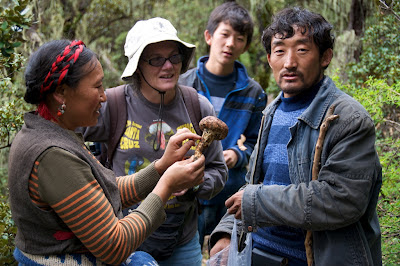
While waiting for a landslide to be cleared—one of the many monsoon-induced road closures that would plague our journey—we met a matsutake buyer who couldn’t contain himself. Though he spoke no English, he must have understood the gist of our conversation as we all waited impatiently beside the muddy jeep track. He grabbed hold of my sleeve and ushered me back to his minivan. As he yanked open the sliding door, I imagined jack-booted authorities jumping out to arrest me, but instead I found myself staring at a carload of mostly #1 matsutake buttons, maybe 500 pounds in all.
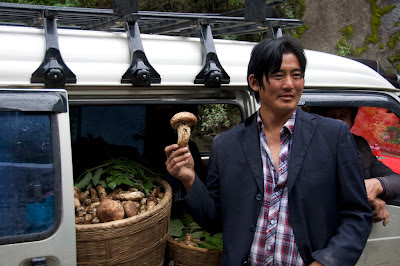
Our high point in terms of elevation was the town of Lithang, birthplace of two Dalai Lamas. At 4,014 meters (or more than 13,000 feet above sea level), it’s one of the highest towns in the world, though it wasn’t a high point for morale. Sleep and appetite suffered in the thin air. Outside the tourist town of Yading we caught a miraculous glimpse of Mt. Chenresig, the sacred Buddhist peak of compassion (6,032 meters), normally shrouded in cloud cover.
The drive from Daocheng to Shangri-la in Yunnan Province passed through miles of awe-inspiring territory. We came across a guy selling a basketful of matsutake out in the middle of nowhere. (Or, more likely, he was waiting for his usual buyer to motor by.) This was a signal to keep our eyes peeled, and sure enough, we rounded a bend and saw a mushroom camp in the distance.
According to the people running the makeshift local store, about forty pickers plus their families had set up the camp in the past week. Some were still moving in.
The temporary settlement, with its simple tents constructed from tarps and wooden stringers cut on site, reminded me of the matsutake camp near Chemult, Oregon. There was a lot of activity as the inhabitants collected wood, shored up their domiciles with brush, and laid in supplies.
Unfortunately there was no time to linger. We had to press on to Shangri-la, a dingy city in Yunnan Province that has appropriated the famous name from Lost Horizon for itself. Yunnan is well known for its wild mushroom trade. Not surprisingly, Shangri-la had a corner of real estate devoted to the buying and selling of precious fungi.
Over the course of the trip, our group had a chance to sample many species of local edible mushrooms that we found along the way, including boletes, blewetts, a beautiful sulfur shelf, and others. We brought them to little family restaurants where there was never a question as to whether the mushrooms were safe to eat. The people know their mushrooms. Only once did a cook remind us that the responsibility was all ours.
Though our trip was built around the foraging and commerce of mushrooms, we also spent welcome time identifying mountain flora, visiting towns along the route, and exploring Buddhist monasteries. Outside Shangri-la I had one last opportunity to hunt mushrooms in China before flying back to Chengdu—on the grounds of a monastery where, among a roving band of pigs, chickens, and goats, I found a pair of perfect Amanita hemibapha eggs and a beautiful Amanita from the vaginata group in the shadow of Tibetan prayer flags, a fitting end to an exciting and educational mushroom hunt.
Like this:
Like Loading...
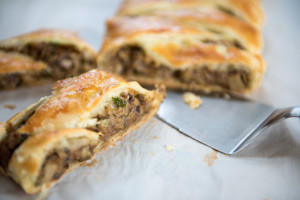 THIS WAS MY FIRST strudel. For this reason I kept things simple and bought frozen puff pastry from the store. You’re welcome to make your own.
THIS WAS MY FIRST strudel. For this reason I kept things simple and bought frozen puff pastry from the store. You’re welcome to make your own.


